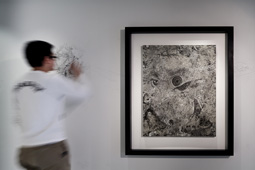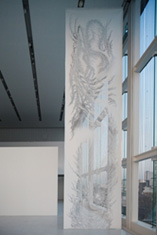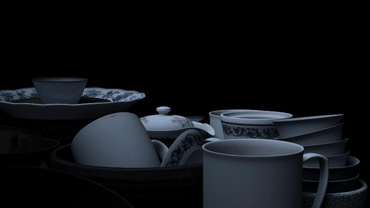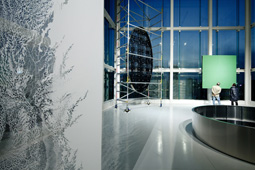 |
|
 |
| Ataru Sato, Sign, 2012 |
|
Tomoko Shioyasu, Bubbles, 2012 |
Commission five very talented Japanese artists of varying ages working in different genres to create works in an inspiring space, and you're bound to get an impressive exhibition. Cosmic Travelers - Toward the Unknown, showing at Espace Louis Vuitton Tokyo until May 6, defines the collaborative spirit and creativity that's possible when generous support is forthcoming.
Louis Vuitton's commitment to the arts is longstanding and intertwined with the brand's 150-year history. Their design collaboration since 2002 with contemporary artist Takashi Murakami was the brainchild of in-house designer Marc Jacobs. The exposure and commercial success of the products catapulted the artist to world fame. Wider support for contemporary art includes the company's gallery Espace Culturel Louis Vuitton in Paris, which has been showing works by both up-and-coming and established artists such as James Turrell, Joseph Kosuth, and Tracey Emin since 2006.
In Tokyo, the art space on the 7th floor of the Louis Vuitton store in Omotesando is the company's second space, opened in January last year. This is their third show and first group exhibition (three shows are planned per year). The five artists were asked to create works on the theme of light, inspired by the space -- light-filled rooms encased by glass windows reaching to the eight-meter-high ceiling, with views of the crowded cityscape below. Given Tokyo's expensive real estate, limited studio space and small galleries, artists working and showing in the metropolis tend to scale down their pieces. Here they could expand, both vertically and horizontally. Some of the artists took six months to a year to complete their site-specific works. The results are a breathtaking and curious combination that sparks the imagination.
 |
|
 |
| Tomoko Shioyasu, Flowing Sky, 2012 |
|
Noriyuki Haraguchi, Triad, 2012 |
Tomoko Shioyasu's Flowing Sky clearly reveals the Japanese penchant for detail, fine craft, and a sense of ephemeral wonder. Her 8 x 2 meter paper work is cut by hand from a single roll of studio paper. Kiri-e -- the art of paper cutting -- has a long tradition in Japan. "I started paper cutting in 2003, intrigued with the beauty of veins in a leaf," Shioyasu explains. "Then the webs formed by netting caught my eye." Her pieces typically take many months of daily work to complete. She does not plan them out, but works intuitively in a kind of meditative state of mind. Colliding and flowing, the intricate, heavenly swirls represent shapes in nature -- water, bubbles, cells, mesh. Light streaming through the work creates an interplay of moving shadows that imbues it with life. Shioyasu calls her work a culmination of chi -- "energy of life." Energetic it is, and it is hard to imagine the shy and unassuming Shioyasu as the creator. "Yes, you could call it powerful," she whispers. Also included in the show is her small-scale 3D collage Bubbles. This work is a delightful series of round bubble-like shapes made of synthetic paper cut with holes and skillfully displayed in a lighted glass case. Shioyasu is represented by Scai the Bathhouse.
With three interactive pieces titled Triad, veteran sculptor Noriyuki Haraguchi asks, "What does it really mean to see?" The pool-like aluminum container on the floor, filled with dark oil that betrays no surface movement, creates a fascinating mirror image of the two standing artworks and the surrounding space. The pieces reflect Haraguchi's long interest in industrial materials, found "things," and their interplay with their environment. As a boy growing up in Yokosuka near one of Japan's largest U.S. naval bases, he first created small-scale models of ships and submarines. During his days in the unofficial Mono-ha "movement" of the late 1960s and early 1970s, he began experimenting with conceptual works that tested the relationship between natural materials and space. Mono-ha was a major catalyst for change in Japan's art world at the time. Until then, modern modes of artistic expression had been mainly borrowed from the West, but Mono-ha paved the way for a new generation of Japanese artists to develop their own practice. Haraguchi's work at Espace reveals years of refinement by a gifted illusionist.
Ataru Sato is Japan's hot new drawing artist, with works exhibited at the prestigious Frieze Art Fair in London and Art Basel in Switzerland. At the Espace show, Sato draws beyond paper and canvas, directly onto the wall. He writes, "The surface of the paper [and wall] is like a laboratory, or even a hospital." His work Omen combines portraiture with a pair of penetrating dark eyes, surrounded by a twisted cornucopia of finely sketched figures and patterns -- bugs, skeletons, body parts, captivating faces. Sato's work, which he calls a portrait of god, is inspired by the steady stream of natural light pouring into the space. "I wanted to draw my own god . . . whom I could rely on spiritually to help me to thrive," he writes. Sato says the smaller "eye drawings" in the show are based on his curiosity about the universe. "As a child I got the vague sense that the universe resembled the human mind," he writes. "I wondered if I could recreate my own little universe by drawing out, lining up and multiplying various things from within my mind." Sato is represented by Gallery Koyanagi.
 |
|
 |
| Masakatsu Takagi, Anyura, 2012; © Louis Vuitton / Jérémie Souteyrat, courtesy of Espace Louis Vuitton Tokyo |
|
Go Watanabe, one landscape, a journey, 2011; courtesy of the artist and Arataniurano |
Go Watanabe hones in on everyday objects with one landscape, a journey, a painfully slow-moving video work of cups and bowls stacked in a kitchen sink. It is not, however, just a test of viewer patience. The "animated" work attempts to question the meaning of animation, dubbed the "illusion of life" in a book by Disney animators. This can be linked with the "animistic" notion -- key to Japanese Shintoism -- that souls or spirits exist in all natural objects. Watanabe says his tableware landscape suggests a world in constant motion, inspired by the panoramic urban landscape seen through the gallery's large glass windows. Watanabe is represented by Arataniurano.
Multimedia artist Masakatsu Takagi combines his talents in art, music and filmmaking into his video Untitled, which is prominently displayed on the first floor of the Louis Vuitton store. It's a fusion of sound and visual imagery that briefly transports one beyond the brand's handbags and luxury goodies -- an inspiring respite filled with the colors of the sun. Takagi has exhibited and performed at art museums, concerts, and film festivals worldwide, and Apple Inc. has commissioned him to create a three-minute promotional video about the Macintosh system and Apple Pro software that he uses in his work. Takagi admits that he's not sure where his many talents come from. In an interview with the online magazine Shift, Takagi says, "Generally, people think creating work equals self-expression, but that has nothing to do with my intention . . . I [feel] more like something [makes] me create it more than creating it myself . . . I can make a piece or play music as if I'm moved by a power that I can't control. It's like you made something well without noticing it." Takagi is represented by Yamamoto Gendai.
 |
|
 |
| Left: Tomoko Shioyasu, Flowing Sky, 2012; right: Noriyuki Haraguchi, Triad, 2012 |
|
Left: Tomoko Shioyasu, Flowing Sky, 2012; right: Ataru Sato, Untitled, 2012
Except where otherwise indicated, all images © Louis Vuitton / Jérémie Souteyrat, courtesy of Espace Louis Vuitton Tokyo
|
|